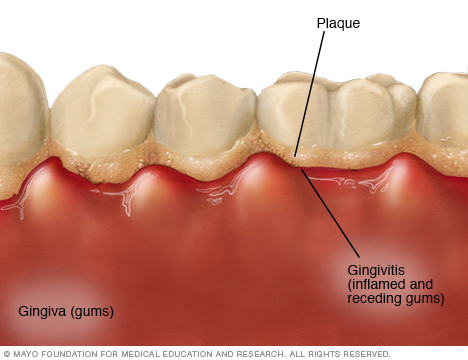Overview
Gingivitis is a common and mild form of gum disease, also called periodontal disease. It causes irritation, redness, swelling and bleeding of your gingiva, which is the part of your gum around the base of your teeth. It's important to take gingivitis seriously and treat it promptly. Gingivitis does not cause bone loss. But left untreated, it can lead to a much more serious gum disease, called periodontitis, and tooth loss.
The most common cause of gingivitis is not keeping your teeth and gums clean and healthy. Good oral health habits, such as brushing at least twice a day, flossing daily and getting regular dental checkups, can help prevent and reverse gingivitis.
Symptoms
Healthy gums are firm and pale pink. They fit tightly around the teeth. Symptoms of gingivitis include:
- Swollen or puffy gums.
- Bright red or dark red gums, or gums that are darker than usual.
- Gums that bleed easily when you brush or floss.
- Tender gums.
- Bad breath.
When to see a dentist
If you notice any symptoms of gingivitis, schedule an appointment with your dentist as soon as possible. The sooner you seek care, the better your chances of reversing damage from gingivitis and not getting periodontitis. Your dentist may want you to see a periodontist if your symptoms aren't improving. This is a dentist with advanced training who specializes in treating gum diseases.

Causes
The most common cause of gingivitis is poor care of teeth and gums, which allows plaque to form on teeth. This causes swelling of the surrounding gum tissues.
Here's how plaque can lead to gingivitis:
- Plaque forms on your teeth. Plaque is a sticky film that has no color. It's mainly made up of bacteria that form on your teeth after eating starches and sugars in food. Plaque needs to be removed every day because it forms quickly.
- Plaque turns into tartar. Plaque that stays on your teeth can harden under your gumline into tartar. This tartar, also known as calculus, then collects bacteria. Tartar makes plaque harder to remove, creates a protective shield for bacteria and irritates the gumline. You need professional dental cleaning to remove tartar.
- Gingiva becomes irritated and swells. The gingiva is the part of your gum around the base of your teeth. The longer that plaque and tartar remain on your teeth, the more they irritate the gingiva. In time, your gums become swollen and bleed easily. This is called gingivitis. If not treated, gingivitis can lead to tooth decay, periodontitis and tooth loss.
Risk factors
Gingivitis is common, and anyone can develop it. Factors that can increase your risk of gingivitis include:
- Poor oral care habits.
- Smoking or chewing tobacco.
- Older age.
- Dry mouth.
- Poor nutrition, including not getting enough vitamin C.
- Repairs to teeth that don't fit properly or are in poor condition, such as fillings, bridges, dental implants or veneers.
- Crooked teeth that are hard to clean.
- Conditions that lower immunity, such as leukemia, HIV/AIDS or cancer treatment.
- Certain drugs, such as phenytoin (Dilantin, Phenytek, others) for epileptic seizures and some calcium channel blockers used for angina, high blood pressure and other conditions.
- Hormonal changes, such as those related to pregnancy, the menstrual cycle or use of birth control pills.
- Certain genes.
- Medical conditions, such as certain viral and fungal infections.
Complications
Untreated gingivitis can lead to gum disease that spreads to underlying tissue and bone, called periodontitis. This is a much more serious condition that can lead to tooth loss.
Ongoing gum disease may be related to some diseases that affect the entire body, such as respiratory disease, diabetes, coronary artery disease, stroke and rheumatoid arthritis. Some research suggests that the bacteria responsible for periodontitis can enter your bloodstream through gum tissue, possibly affecting your heart, lungs and other parts of your body. But more studies are needed to confirm a link.
Trench mouth, also known as necrotizing ulcerative gingivitis or NUG, is a severe form of gingivitis that causes painful, infected, bleeding gums and ulcers. Trench mouth is rare today in developed nations, though it's common in developing countries that have poor nutrition and poor living conditions.
Prevention
To prevent gingivitis:
- Practice good oral care. That means brushing your teeth for two minutes at least twice daily — in the morning and before going to bed — and flossing at least once a day. Better yet, brush after every meal or snack or as your dentist recommends. Flossing before you brush cleans away loosened food particles and bacteria.
- Go to the dentist regularly. See your dentist or dental hygienist regularly for cleanings, usually every 6 to 12 months. If you have risk factors that increase your chance of developing periodontitis — such as having dry mouth, taking certain medicines or smoking — you may need professional cleaning more often. Annual dental X-rays can help pinpoint diseases not seen by a visual dental exam and watch for changes in your dental health.
- Take steps to lead a healthy lifestyle. Practices such as healthy eating and managing blood sugar if you have diabetes, for example, also are important to supporting gum health.
Diagnosis
Dentists usually diagnose gingivitis based on:
- Review of your dental and medical history and conditions that may contribute to your symptoms.
- Looking at your teeth, gums, mouth and tongue for signs of plaque, irritation or swelling.
- Measuring the pocket depth of the groove between your gums and teeth. A dental probe is inserted beside your tooth beneath your gumline, usually at several sites in your mouth. In a healthy mouth, the pocket depth is between 1 and 3 millimeters (mm). Pockets deeper than 4 mm may mean gum disease.
- Dental X-rays to check for bone loss in areas where your dentist sees deeper pockets.
- Other tests as needed. If it's not clear what has caused your gingivitis, your dentist may recommend that you get a medical evaluation to check for other health conditions. If your gum disease is further along, your dentist may refer you to a periodontist. This is a dentist with advanced training who specializes in treating gum diseases.
Treatment
Prompt treatment usually reverses symptoms of gingivitis and prevents it from leading to more-serious gum disease and tooth loss. You have the best chance for successful treatment when you also practice good oral care daily and stop using tobacco.
Professional gingivitis care includes:
- Dental cleaning. Your first professional cleaning will include the removal of all traces of plaque, tartar and bacterial products. This procedure is known as scaling and root planing. Scaling removes tartar and bacteria from the surface of your teeth and under your gums. Root planing removes the bacterial products produced by swelling and irritation, and it smooths the root surfaces. This discourages further buildup of tartar and bacteria, and it allows proper healing. The procedure may be done using instruments, a laser or an ultrasonic device.
- Any needed dental repairs. Crooked teeth or poorly fitting crowns, bridges or other dental repairs may irritate your gums and make it harder to remove plaque during daily oral care. If problems with your teeth or dental repairs play a part in your gingivitis, your dentist may recommend fixing these problems.
- Ongoing care. Gingivitis usually clears up after a thorough professional cleaning — as long as you continue good oral care at home. Your dentist will help you plan an effective at-home program and a schedule of regular checkups and cleaning.
If you follow your dentist's suggestions and regularly brush and floss your teeth, healthy gum tissue should return within days or weeks.
Lifestyle and home remedies
Steps you can take at home to prevent and reverse gingivitis include:
- Brush your teeth twice a day or, better yet, after every meal or snack.
- Use a soft toothbrush and replace it at least every three months.
- Think about using an electric toothbrush, which may remove plaque and tartar better.
- Floss daily. If you have a hard time handling dental floss, try a floss holder. Or floss with a dental pick, brush or stick designed to clean between your teeth. Work with your dentist or dental hygienist to determine the best dental tool that fits your needs.
- Use a mouth rinse to reduce plaque between your teeth.
- Get regular professional dental cleanings on a schedule recommended by your dentist.
- Don't smoke or chew tobacco.
Preparing for an appointment
Follow your dentist's recommended schedule for regular checkups. If you notice any symptoms of gingivitis, make an appointment with your dentist. Here's some information to help you get ready for your appointment and know what to do to prepare.
What you can do
To get ready for your appointment, make a list of:
- Symptoms you have, including any that don't seem related to the reason for your appointment.
- Key personal information, such as any medical conditions you may have.
- All medicines you take, including vitamins, herbs or other supplements, and the doses.
- Questions to ask your dentist to make the most of your time together.
Some questions to ask your dentist may include:
- Do you think gingivitis is causing my symptoms?
- What kinds of tests do I need?
- Will my dental insurance cover the treatments you're recommending?
- What are the options to the approach you're suggesting?
- What steps can I take at home to keep my gums and teeth healthy?
- What kind of toothpaste, toothbrush and dental floss do you recommend?
- Do you recommend using mouthwash?
- Are there any restrictions that I need to follow?
- Are there any brochures or other printed material that I can have?
- What websites do you recommend?
Do not hesitate to ask other questions during your appointment.
What to expect from your dentist
Your dentist may ask you questions about your symptoms, such as:
- When did you begin feeling symptoms?
- Have you been feeling these symptoms all of the time or only once in a while?
- How often do you brush your teeth?
- How often do you floss your teeth?
- How often do you see a dentist?
- What medical conditions do you have?
- What medicines do you take?
Preparing and expecting questions will help you make the most of your time.
© 1998-2024 Mayo Foundation for Medical Education and Research (MFMER). All rights reserved. Terms of Use


